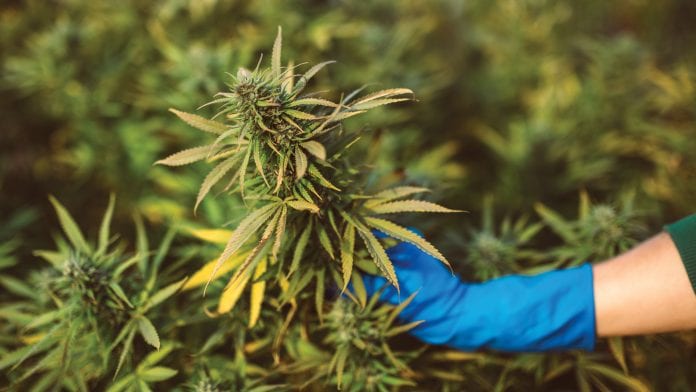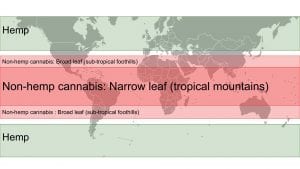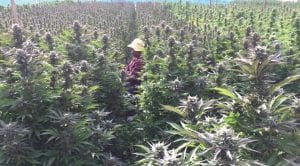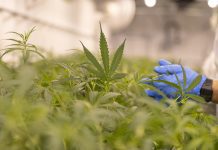
Global cannabis prohibition is ending, and supply of legal cannabis is increasing. Here, Jim Plamondon of Thai Cannabis talks more about the sustainable future for cannabis.
When the supply of cannabis exceeds demand, its wholesale price is predicted to collapse1 by at least 90% from current US wholesale prices.2 What will cannabis’ global supply chain look like after this global cannabis price collapse? As the Hungarian-British physicist Dennis Gabor stated,3 “The future cannot be predicted, but it can be invented.”
This article calls on Europeans to work with farmers in the developing nations to invent, together, a sustainable future for cannabis, by defining and implementing the standards, institutions, and businesses on which a sustainable global cannabis supply chain can be built. I have established the SmallCannabis™ Foundation4 to lead the SmallCannabis Initiative in organising this SmallCannabis global cannabis supply chain – but I need your help!
In the context of SmallCannabis, I define ‘cannabis’ to mean cured, legal flowers of cannabis sativa L. (and any subspecies and hybrids thereof, excluding hemp) and the extracts of said flowers.5 By helping farmers in the developing nations bring the proposed SmallCannabis global supply chain into existence, Europeans can empower farmers in the developing nations to increase the quality of Europe’s cannabis, reduce its cost, and improve its sustainability.
Why the developing nations?
Because the combination of cannabis’ optimal terroir6 and low wages is found only in the developing nations.
Optimal terroir
Cannabis originated in Asia, where for thousands of years Asia’s smallholder farmers bred the indica strains of cannabis to thrive in the hot, dry summers of the sub-tropical Himalayan foothills,7 and the sativa strains to thrive on the tropical mountains of Southeast Asia (notably Thailand). Both locations are on the equatorial side of 35° latitude,8 which facilitates a long flowering period of nearly equal length days. In this optimal terroir for (non-hemp) cannabis, hundreds of generations of smallholder farmers steadily improved their cannabis strains and production techniques to produce exquisite cannabis. Meanwhile, cannabis spread westward9 to similar terroir in Africa, the Caribbean, and the Americas.
Continental Europe is too far north to have optimal terroir for cannabis (see Fig. 110), just as it is too far north to have optimal terroir for cocoa, coffee, and vanilla. Nonetheless, one could grow these crops profitably in European greenhouses if the price were high enough.
As Adam Smith pointed out11 in The Wealth of Nations, “by means of glasses, hotbeds, and hotwalls, very good grapes can be raised in Scotland, and very good wine too can be made of them at about thirty times the expense for which at least equally good can be brought from foreign countries.” The same is true for cannabis.12

Modern “glasses, hotbeds, and hotwalls” for cannabis are remarkably expensive to build and operate. In Canada, Aurora Cannabis’ Aurora Sky greenhouse13 cost €100 million and Aphria’s Aphria One greenhouse14 cost €125 million. Operating them requires simulating cannabis’ optimal terroir: blocking excessive sunlight during too-long summer days, powering electric lights during too-short winter days, and controlling temperature and humidity year round.
On the other hand, in optimal terroir, cannabis’ light source is the sun, its ideal temperature and humidity are the local climate, and its greenhouse is the sky. The cost to ‘build and operate’ the sun, climate, and sky is zero, making it much less expensive to farm cannabis in its optimal terroir than elsewhere (all else being equal).
Low wages
Another important cost-driver is labour. Europe’s wages are among the highest in the world, with seven of the top ten national minimum wages15 being European (with the other three being Australia, New Zealand, and Canada). These high wages are ill suited to industries that rely primarily on hand labour, such as growing high quality flowers. That’s why much of the world’s cut-flower industry has moved to developing nations16 such as Colombia, Ecuador, and Kenya, where wages are lower and terroir is optimal for cut flowers.
As price competition among cannabis companies increases, they are likely to seek to reduce their cost of production by expanding their global supply chains into nations that offer optimal terroir for cannabis, low wages, and cannabis legalisation. Indeed, that is already happening, with North American cannabis companies expanding production in Colombia,17 Jamaica,18 and Lesotho.19
Nations that offer this combination of optimal terroir for cannabis, low wages, and cannabis legalisation are, potentially, ‘SmallCannabis-producing nations.’ The combination of optimal terroir and low wages can dramatically reduce the cost – and hence the price – of cannabis.
To quote Kyle Detwiler,20 CEO of Northern Swan Holdings, by growing cannabis in a SmallCannabis-producing nation, “We can cut our price 90% and still make money.”
Conclusion: SmallCannabis will be less expensive.
Quality
When cannabis prohibition began, cannabis enthusiasts in ‘the West’ (notably North America, Europe, and Australia) tried to grow the legendary sativa strains21 that they were prohibited from importing. However, these tropical sativa strains required longer summers than the West’s temperate climates provided. Hybridisation with faster maturing indica strains produced new strains that could mature outdoors in the temperate zone, albeit with a loss of quality.

When police started using helicopters to find outdoor cannabis farms (of sativa hybrids and pure indicas), hybridisation with Russian ruderalis produced new strains that matured even faster and at shorter height. This allowed cannabis farmers to shift their production indoors, away from the helicopters – although, again, with a loss of quality.
Since then, Western breeders have produced a dizzying range of cannabis strains, some of which have arguably overcome the loss of quality that resulted from their production focused hybridisations.
Now that cannabis has been relegalised in nations with optimal terroir, the superior old strains22 should become available again, in all their diversity. We should also expect to enjoy new strains that have been bred from provenance assured old strains solely for quality, rather than being bred to mature in a sub optimal climate or in a police evading basement.
Learning from similar efforts with other crops, the SmallCannabis Initiative can help sustain the diversity of cannabis strains (perhaps by using a model similar to the Cocoa of Excellence Programme23) and bring cannabis to the European market efficiently (perhaps by using a model similar to CaféDirect’s24). This can give new hope to the communities in the developing nations whose ancestors created the pure old strains from which all modern Western strains were derived. On optimal terroir, earning a living income25, farmers in the developing nations can afford to invest the hand labour that is required to produce the highest-quality cannabis.26,27
Conclusion: SmallCannabis will be higher quality.
Sustainability
Although we can reasonably assume that today’s cannabis companies have the best of intentions, we should also be aware that global agricultural supply chains have been implicated in some terrible outcomes, such as:
- Cocoa28: “Farmers may fall into the debt trap and sell a family member as a slave.”
- Coffee29: “Nestlé admits slave labour risk on Brazil coffee plantations.”
- Vanilla30: In Madagascar, the top vanilla exporter, “Nearly one in two children are stunted, meaning they are likely to grow up either physically or mentally disadvantaged.”
These terrible outcomes arose from the interaction of many historical, commercial, and local factors, including ‘boom and bust’ cycles that make famers’ income unpredictable and poverty-induced coping strategies such as deforestation31, child and forced labour32, and excessive debt.33
Cannabis has two unique advantages in avoiding these terrible outcomes. Firstly, legal cannabis is the first entirely new global agricultural supply chain to be built after:
- Technological innovations such as the Internet, the smartphone, cloud computing, QR codes, RFID tags, blockchain, and the Sustainable Rice Platform34;
- Commercial innovations such as Fair Trade35, CocoaLife36, CaféDirect37, the SAI Platform38, TechnoServe39, the Cocoa of Excellence Programme40, and modern impact investing;41 and
- Political innovations such as the Generalised System of Preferences42, the Everything but Arms43 programme, and the UN’s Sustainable Development Goals.44
With cannabis, we can combine selected innovations with proven best practices to establish a paperless, digital only sustainable global supply chain that transparently, traceably, and efficiently connects consumers to producers.
Secondly, the rapid spread of legalisation, combined with the slow pace of regulatory implementation and the high cost of building cannabis farms in non-optimal terroir, has created a global shortage of legal cannabis. This shortage has kept prices temporarily high. Cannabis farmers in the developing world have a few more years of high margins, which can help fund the development of the SmallCannabis supply chain – but only if we act quickly.
The goals of SmallCannabis should be the goals of sustainability:
- People45: A living income for everyone in the global cannabis supply chain, without exploiting any worker;
- Planet46: Improvement to the global environment, without exploiting any local ecology; and
- Profits47: Market-based solutions that deliver cannabis of appropriate quality for each intended use while meeting all European standards, without exploiting any consumer (with inferior products) or investor (with inferior returns).
Conclusion: SmallCannabis will be more sustainable.
Why exclude hemp?
Because the optimal terroir for hemp is on the polar side of 45° latitude, where long summer days help hemp to grow tall (with relatively few, and smaller, flowers). This zone includes broad regions of Northern Europe, North America, and Asia, and smaller regions of Southern Australia, South America, and New Zealand. The mechanised agriculture of these regions is well suited to farming hemp for fibre and edible hempseed. The nations in this hemp-optimal region can grow hemp and trade it to the SmallCannabis producing nations for cannabis. Everybody wins!
Why Europe?
Because Europe is predicted to become the largest market for cannabis products48 by 2022. As the largest cannabis buyer, Europe can have the most influence on shaping cannabis’ global supply chain.
For decades, the EU has given tariff reducing trade preference to imports from developing nations through schemes such as the Generalised Scheme of Preferences (GSP), GSP+, and Everything But Arms (EBA). These schemes have helped developing nations join and benefit from global trade, reducing poverty, enhancing sustainability, and improving social justice.
This article proposes that cannabis be included within those schemes, and specifically to include cannabis produced in the upper middle-income developing nations that have suffered most from the global ‘War on Drugs,’49 such as Mexico,50 Colombia,51 Jamaica,52 and Thailand.53
Why now?
By working together now, before the global cannabis price collapse, we can afford to build a technology-enabled, transparent, traceable, and (above all) sustainable global supply chain, rooted in the developing nations, which can then serve as a model to increase the sustainability of all other commodities sourced from those nations. Today, the world’s first SmallCannabis -producers are already organising – but they need your help.
Conclusion
SmallCannabis gives Europeans the opportunity to obtain higher quality cannabis at a lower price, produced by a more sustainable global supply chain. However, SmallCannabis – being rooted in the relatively-poor developing nations – needs the support of individual Europeans and the companies, NGOs, government agencies, etc., that they represent.
Don’t wait! Take your first step today to help invent a sustainable future for cannabis: SmallCannabis.
First steps
- Imagine: How could your company, NGO, government agency, etc. add value to a link in SmallCannabis’ global supply chain?
-
- Could you help define and implement a sustainable cannabis farming system, like the Sustainable Rice Platform?54
- Could you help define and implement a farmer-centric cannabis processing and distribution system, like California’s Flow Kana?55
- Could you help define and implement a sustainable cannabis sales & marketing system, like CaféDirect?56
- Could you help define and implement a programme for enhancing cannabis quality and diversity, like the Cocoa of Excellence Programme?57
- Could your app, platform, or other technology help to achieve the sustainability objectives of the SmallCannabis global cannabis supply chain?
- Could you help define and implement sustainable finance58 for the SmallCannabis global cannabis supply chain?
- Register to participate in the organising workshop for SmallCannabis.59
- Post this link to social media: [link to online version of this article].
Come change the world with me! Let’s all work together to get cannabis right from the start.
References
- https://thaicannabiscorporation.com/2018/11/07/cannabis-global-price-collapse/
- https://reports.cannabisbenchmarks.com/
- https://quoteinvestigator.com/2012/09/27/invent-the-future/
- SmallCannabis™ is a trademark of the SmallCannabis Foundation
- The taxonomy of cannabis is debated, with ‘lumpers’ lumping all cannabis into one species and ‘splitters’ splitting cannabis into three or more species. Noting that any definition will attract dissent, this article uses the traditional three-species split (sativa, indica, and ruderalis) and defines ‘hemp’ as any Cannabis strain with THC < 0.3%
- https://en.wikipedia.org/wiki/Terroir
- https://en.wikipedia.org/wiki/Köppen_climate_classification#Cwa:_Drywinter_humid_subtropical_climate
- https://therichardrosereport.com/articles/oxymoron-tropical-hemp/
- https://onlinelibrary.wiley.com/doi/abs/10.1111/j.1931-0846.2014.12038.x
- Source: The Richard Rose Report
- https://books.google.co.th/books?id=n1FHAAAAYAAJ&pg=PA351&lpg=PA351&dq=%22very+good+wine+too+can+be+made+of+them+at+about+thirty+times+the+expense%22&source=bl&ots=R7l_xr_jul&sig=ACfU3U36z1zxmt0WHqFz4OC5DYV6r1bBjQ&hl=en&sa=X&ved=2ahUKEwisxYPFsonkAhW48HMBHbJJDVMQ6AEwAXoECAkQAQ#v=onepage&q=%22very%20good%20wine%20too%20can%20be%20made%20of%20them%20at%20about%20thirty%20times%20the%20expense%22&f=false
- Please recall that, in this article, ‘cannabis’ is defined to exclude hemp
- https://mjbizdaily.com/auroras-ca150-million-cannabis-greenhouse-licensed-cultivation-sales/
- https://mjbizdaily.com/aphrias-flagship-ca190-million-cannabis-greenhouse-is-fully-licensed/
- https://ceoworld.biz/2019/01/03/countries-with-the-highest-minimum-hourly-wages-in-the-world-2019/
- https://sk.sagepub.com/cases/royal-floraholland-strategic-supply-chain-of-cut-flowers-business
- https://www.investopedia.com/why-colombia-poses-a-threat-to-cannabis-stocks-4689330
- https://www.thegrowthop.com/cannabis-business/small-caribbean-island-offers-big-opportunities-for-canadian-cannabis-companies-local-communities
- https://www.newcannabisventures.com/tag/lesotho/
- https://www.investopedia.com/why-colombia-poses-a-threat-to-cannabis-stocks-4689330
- https://thediplomat.com/2018/04/thailands-legendary-marijuana/
- https://www.vice.com/en_in/article/9kxzxy/a-scientist-in-jamaica-is-recreating-the-supreme-ganja-pot-bob-marley-smoked
- http://www.cocoaofexcellence.org/
- https://www.cafedirect.co.uk/
- https://www.living-income.com/the-concept
- Some argue that automation can replace hand labour on cannabis farms. If that were true, why aren’t high wage regions like Europe and the USA winning back the cut-flower industry from the developing nations?
- https://www.royalqueenseeds.com/blog-should-you-hand-trim-or-machine-trim-your-cannabis-n1128
- https://www.imvoconvenanten.nl/~/media/files/imvo/banking/news/imvo-cocoa-value-chain-analysis-en.ashx
- https://www.theguardian.com/global-development/2016/mar/02/nestle-admits-slave-labour-risk-on-brazil-coffee-plantations
- https://www.ft.com/content/02042190-65bc-11e8-90c2-9563a0613e56
- https://plantwithpurpose.org/poverty-deforestation/
- https://www.dol.gov/general/apps/ilab
- http://www.licadho-cambodia.org/reports.php?perm=228
- http://www.sustainablerice.org
- https://www.fairtrade.org.uk/What-is-Fairtrade
- https://www.cocoalife.org
- https://assets.publishing.service.gov.uk/media/57a08d8ee5274a31e000191e/R7285NRET_Working_Paper_6.pdf
- https://saiplatform.org
- https://www.technoserve.org/
- http://www.cocoaofexcellence.org
- https://www.investopedia.com/news/history-impact-investing/
- https://ec.europa.eu/trade/policy/countries-and-regions/development/generalised-scheme-of-preferences/
- https://trade.ec.europa.eu/tradehelp/everything-arms
- https://news.un.org/en/story/2015/09/509732-un-adopts-new-global-goals-charting-sustainable-development-people-and-planet
- https://www.living-income.com/the-concept
- https://daily.jstor.org/the-environmental-downside-of-cannabis-cultivation/
- https://www.businessfordevelopment.org
- https://thegreenfund.com/europe-the-worlds-largest-cannabis-market
- https://transformdrugs.org/wp-content/uploads/2018/10/CTC-Security-briefing.pdf
- https://www.ft.com/content/69346c82-338c-11e9-bb0c-42459962a812
- http://witnessforpeace.org/wp-content/uploads/2017/08/reportontheimpactoftheu.s.warondrugscolombiafinal.docx
- https://www.counterpunch.org/2019/06/14/edward-seaga-and-the-institutionalization-of-thuggery-violence-and-dehumanization-in-jamaica/
- http://host319.hostmonster.com/suspended.page/disabled.cgi/www.philrights.org
- http://www.sustainablerice.org
- https://www.flowkana.com/home
- https://assets.publishing.service.gov.uk/media/57a08d8ee5274a31e000191e/R7285NRET_Working_Paper_6.pdf
- http://www.cocoaofexcellence.org
- https://www.sustainalytics.com/sustainable-finance/2019/03/06/trends-in-sustainable-finance-for-2019/
- www.SmallCannabisFoundation.org
Jim Plamondon
VP Marketing
Thai Cannabis Corporation
+66 098 682 1908
jim.plamondon@thaicannabiscorporation.com
https://thaicannabiscorporation.com/
This article will appear in issue 11 of Health Europa Quarterly, which will be published in October 2019.



















This feels very neo-colonial.